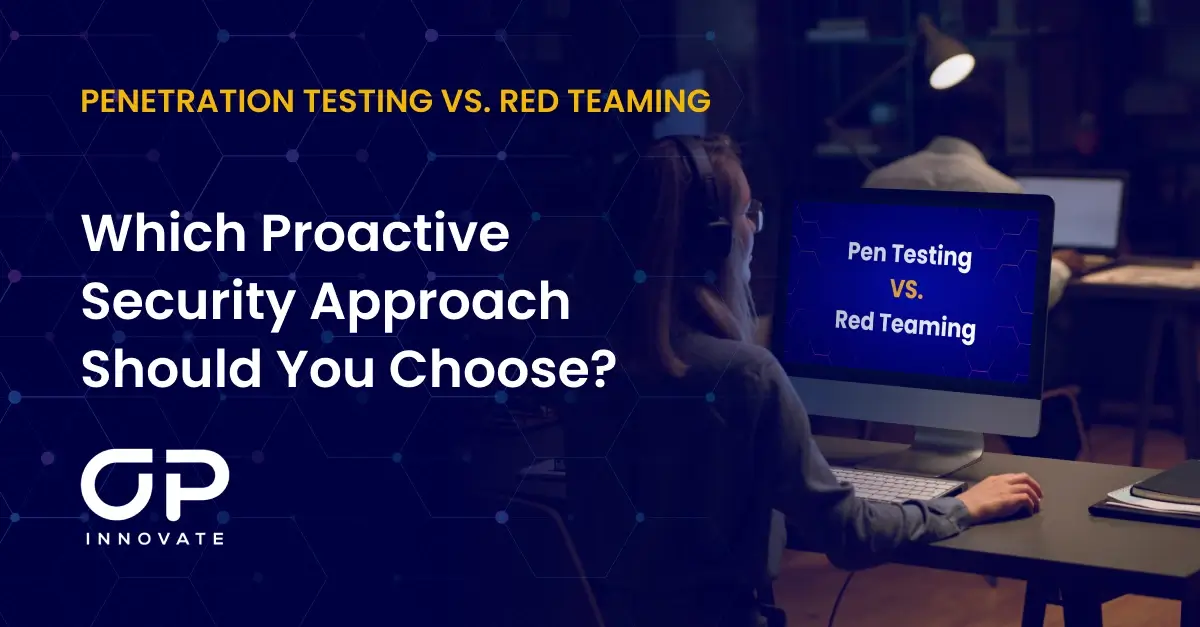Penetration Testing vs. Red Teaming: Which Proactive Security Approach Should You Choose?
In the world of offensive security, there are two approaches that people often confuse: Penetration Testing and Red Teaming. While the two are related and are both advantageous, there are some stark differences you must understand when making a decision for your business.
In this post, we will explore each type of assessment, analyze the pros and cons, and help you determine which approach best suits your organization’s specific needs and security objectives.
What is Penetration Testing?
Penetration testing, also known as “Pen Testing,” is a controlled and systematic simulation of an attack on an organization’s systems, networks, and applications. The idea is to identify and secure vulnerabilities before an attacker finds and exploits them.
Conducted with the organization’s full knowledge and cooperation, the primary goal of penetration testing is to identify and exploit as many vulnerabilities as possible. To do so, the client company and the penetration testers agree on the “Rules of Engagement” for the test, which includes defining the scope, objectives, and boundaries of the testing process.
Here, both parties also agree on the level of access the testers will have prior to execution:
- Black box: The testers have no prior knowledge of the system, simulating an external hacking attempt.
- Grey box: Partial knowledge and access, mimicking an attack by an insider with limited privileges.
- White box: Full knowledge and access, allowing for a thorough examination from an internal perspective.
Pen Testing provides intelligence and insight into the necessary improvements to your IT and R&D infrastructure by understanding how you could be and likely will be attacked. In the final penetration testing report, the testing team also provides remediation steps for any identified vulnerabilities.
While traditional reports have been a staple in the industry for many years, innovative vulnerability management platforms like OP Innovate’s WASP provide interactive reports that can be accessed for continuous pen testing and streamlined remediation.
What is a Red Team Assessment?
Red Teaming is a comprehensive assessment of a company’s publicly-facing threat surface. Unlike a regular penetration test, which identifies vulnerabilities in specific apps, systems, or networks, a red teaming engagement simulates a real-world attack scenario to evaluate not only technical vulnerabilities but also the organization’s detection and response capabilities.
The goal of a red team engagement is to evaluate an organizaiton’s overall security posture, identifying any gaps that need to be filled. Red team assessments often span several weeks or months, allowing for a thorough and persistent approach that mimics real-world cyber attack scenarios. This helps uncover weaknesses that might not be evident in shorter, more focused penetration tests.
Instead of focusing on a particular system or network, you’ll provide your red team with a specific objective or goal. They will then test your defensive strategies to evaluate their effectiveness, offering a more comprehensive and realistic assessment of your overall cybersecurity posture.
Differences Between Pen Testing and Red Teaming
You can think of red teaming engagements as a burglar trying to enter a house. They will exploit the first vulnerability they find, such as an unlocked door, and then move inside the house. Their next objective is to find rooms or safes with high-value assets and try to access them as well.
In cybersecurity terms, once the red team gets access, they will move laterally across the environment to identify critical assets and test the organization’s capabilities to defend them.
On the other hand, a penetration test will test each door, window, and any other potential entry point to identify all vulnerabilities that a potential attacker might exploit.
In terms of costs, red team engagements are typically more expensive than penetration tests due to their scope, time, and resources they require.
Take a look at the table below for more side-by-side comparisons across various categories:
| Red Teaming | Penetration Testing | |
| Objective | Simulate real-world attacks to assess overall security posture | Identify vulnerabilities in specific systems, networks, or applications |
| Scope | Wide-ranging, involving multiple attack vectors | Targeted, focused on specific systems or scenarios |
| Approach | Mimics attacker behavior to test defenses and incident response | Uses predefined methods to find and exploit vulnerabilities |
| Required Expertise | High-level expertise in offensive cybersecurity | Can be conducted by both internal and external security professional |
| Duration | Long-term engagements (weeks to months) | Short-term engagements (days to weeks) |
Choosing The Best Approach for Your Organization
Now that you know how both of these offensive security methods work, how do you choose which one works best for your organization?
Between the two, penetration testing is more popular, as it’s more accessible for organizations of all sizes. Moreover, security policies within frameworks and standards like PCI DSS, GDPR, and ISO 27001 might require regular penetration testing to maintain compliance.
However, there is real value in the additional insights and comprehensive evaluation of your security posture that red teaming engagements provide.
The main factor will be the maturity of your security program. If you’re just starting out, it’s best to cover the basics first with a general vulnerability assessment and penetration testing before moving on to more complex tests like red teaming. If basics such as patch management, and detection and response capabilities haven’t been covered, you will likely not gain much value from a red team test.
Key Considerations
- Organizational Maturity: If your organization already has a robust cybersecurity program and regularly conducts penetration tests, red teaming can provide a more in-depth and realistic assessment of your security defenses.
- Compliance Requirements: If meeting regulatory compliance is a primary concern, penetration testing is essential to ensure you adhere to the necessary standards and frameworks.
- Resource Availability: Penetration testing is generally more cost-effective and requires fewer resources than red teaming, making it a more viable option for SMBs.
- Security Objectives: Define what you aim to achieve. If your goal is to identify technical vulnerabilities for a specific system or application and fix them, penetration testing is suitable. If you want to test your organization’s overall readiness against sophisticated attacks, red teaming is the way to go.
OP Innovate’s Comprehensive Offensive Security Solutions
To fit the varying needs of modern organizations, OP Innovate provides both penetration testing and red teaming services within the WASP solution.
We combine routine pen test sprints run by our CREST-certified offensive security team with our innovative WASP platform, offering continuous scanning and reconnaissance. Our hybrid Web Application Penetration Testing approach offers the best of both worlds, leveraging the efficiency of automation while harnessing the expertise of human testers.
If you have vulnerabilities, we will find them and help you mitigate them fast.
Once you’ve conducted several penetration tests across your digital assets, you can benefit from OP Innovate’s Red Teaming service. Our exercises mimic the tactics, techniques, and procedures (TTPs) of real-world attackers, uncovering vulnerabilities across your entire infrastructure, applications, and personnel.
Get in touch now to learn more and get started on your journey toward a stronger, more resilient cybersecurity posture.









